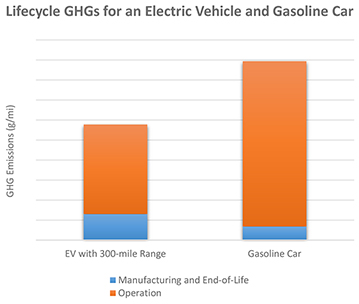Due to the spread of misinformation in recent years, many people are confused about the merits of electric vehicles (EVs) when it comes to their carbon footprint. Some believe that gas-powered cars and trucks are greener. But scientists have refuted that notion. Today’s EVs are cleaner than traditional cars over a lifetime of ownership, and their carbon emissions are on a downward trend. Here’s how both types of vehicles stack up.
Unlike gas-powered vehicles, EVs don’t need an exhaust system. Without tailpipe emissions to consider, it’s easy to assume that EVs are emission-free vehicles. But there are other important factors in the equation.
Manufacturing
EVs and gas-powered cars share many components, but their power plants are vastly different. Generally, it’s less energy intensive to manufacture internal combustion engines than it is to produce EV batteries, which involves a complex supply chain. Mining for raw materials like lithium continues to be a carbon-intensive practice. Some large-scale battery factories are powered by fossil fuels. And EV battery recycling is currently a very tricky proposition.
However, battery-makers are on the cusp of a clean technology revolution. For example, leaders in this space are committed to eliminating cobalt, a rare and toxic metal, from batteries. And new breakthroughs that make batteries stronger, safer, and simpler to recycle are cropping up every year. As noted in a previous blog post, watch for lithium ferro phosphate battery formulations to make a big splash in the coming years. In the long term, we may see solid state or graphene batteries become commercially viable.
Electricity
Not all electricity is created equal. In areas where the energy grid is not decarbonized, EV users end up fueling a “clean” vehicle with “dirty” power. The good news is that production of electricity from coal in the US has fallen from 45% to 28% in less than a decade, according to the nonprofit Union of Concerned Scientists. Indeed, electricity’s ability to be generated from renewable sources gives EVs a distinct advantage over petroleum-fueled vehicles, which have fixed fuel economy ratings and less potential for emissions improvement.
Non-exhaust emissions
This is an issue that affects vehicles of all stripes. While tailpipe emissions receive the most attention, tire wear and brake dust are quietly contributing to a less-publicized crisis. The large, heavy vehicles that are so popular in North America may actually shed around as much fine particulate matter and soot during operation as what is emitted from the exhaust. This pollutes waterways and the air with a toxic aerosol and can lead to health problems, lung issues chief among them.
One advantage that an EV has in this regard is its regenerative braking mechanism. Upon deceleration, an EV’s motor disengages and acts as a generator, capturing the kinetic energy of the spinning wheels as they slow down and storing the charge in the battery. This can reduce the amount of times a driver needs to use the traditional hydraulic disk brakes that create friction and shed problematic metallic debris.
Studies conclude that today’s EVs emit about 200 grams of CO2 per mile, while gas-powered cars emit around 275 grams. By improving some of the above issues, EVs have the potential to emit just 50 grams of CO2 per mile one day. But even right now, electric cars are a green choice for virtually any American: 94% of people in the US live where driving an EV produces less emissions than using a 50 mpg gasoline car.

Source: EPA
As alluded to earlier, EVs in certain parts of the country are cleaner to operate based on the emissions of local power plants. The average electric car driven in California has emissions equal to a 122 mpg gasoline car. In upstate New York, a gasoline car would need to get 231 mpg to have emissions as low as the average EV.
Researchers are seeing car ownership rates skyrocket and are sounding alarm bells around unnecessary car trips. Indeed, ride sharing, public transit, cycling and walking are all greener modes of transportation. But it’s not unreasonable to picture a world in which EVs set an even higher standard for environmental friendliness. A decarbonized grid, more refined battery design and recycling processes, and other emerging technologies will greatly reduce greenhouse gas emissions.
Sources:
https://www.epa.gov/greenvehicles/electric-vehicle-myths
https://www.bbc.com/news/science-environment-51977625
https://www.emissionsanalytics.com/news/pollution-tyre-wear-worse-exhaust-emissions
https://electricautonomy.ca/2019/09/11/better-braking-another-way-evs-clear-the-air/
https://driving.ca/column/how-it-works/how-it-works-regenerative-braking
Photo by David Stamm on Unsplash


